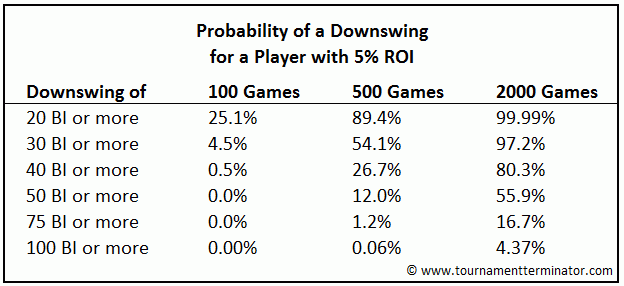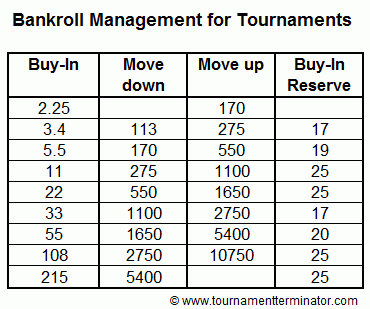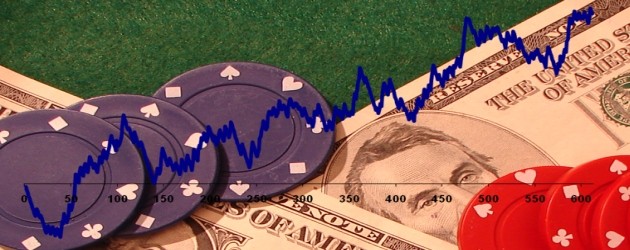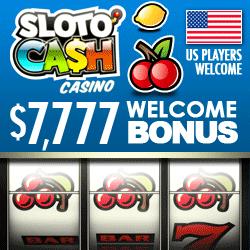Recommended Poker Room
In this article, we describe the principles of bankroll management (BRM) for poker tournaments (Sit and Go’s, Double or Nothing and multi-table tournaments) and show how important adherence to the BRM is in order to avoid to going “broke”. To understand this strategy article, it is important that you know what ROI (Return on Investment) means.
Introduction to Bankroll Management for Poker Players
The bankroll is the sum of money,
- that you have in the player accounts of various online poker rooms (if you play in multiple rooms, you can add the amounts)
- and that you have in your accounts at online payment services like Skrill / Moneybookers or Neteller, which you want to use solely for playing online poker
Theoretically, you could also add the money which you have withdrawn from profits achieved in the past or money which you don’t directly need for living. But this would contradict the principles of separating poker money from money that you need for your living.
Bankroll Management is Necessary
An ambitious tournament players should look at his bankroll through the eyes of an entrepreneur: It is the capital which you are investing in your businesses (poker tournaments). And for this capital, you expect a certain return on investment (ROI) for the time spent and the risks taken. If you have no capital (bankroll) anymore, then you’re broke and the company would have to be be liquidated (you have to find a new hobby). A clever entrepreneur will only invest small amounts of his capital into individual transactions, to avoid concentration risk, which may endanger the survival of his company.
And in exactly the same way you should think a poker player: “What percentage of my bankroll can I invest in poker tournaments, without risking to eventually going broke?”. And this is what is understood by talking about online poker bankroll management (BRM). BRM is therefore a measure to keep the risk of going broke small.
Actual and Expected Return on Investment (ROI)
When talking about ROI, we must distinguish between two measures: the actual ROI is the ROI, which can be determined for a certain time period or a certain amount of games that were played in the past. The expected ROI is the ROI which one should achieve over an extremely large sample size. This value is hypothetical, since no one can play 100,000 SnG’s in a very short period of time without changes in the equation, such as changes in the quality of opponents or changes in the own way of playing. But at least, the following is true: the more tournaments you play, the closer is your actual ROI to the expected ROI.
Impact of ROI on Bankroll Management
BRM is all about ensuring not going broke. The expected ROI of a player must therefore necessarily be positive; otherwise the player will sooner or later go bankrupt anyway. The higher the expected return on investment of a player is, the lower the probability of a total loss is. A player who achieves only 1% ROI in the long term must have a much bigger bankroll available as a player with 20% expected ROI. This should be clear: A mediocre player will more often have long periods of downswings than a professional poker player who usually crushes his competition.
Our recommendations for bankroll management are aimed at players who beat the current buy-in level at which they are playing, which means that they have an expected ROI of 5-10%. Players who think they have an even higher ROI can work with smaller bankroll requirements. Players who think that they don’t achieve 5% ROI should play with a bigger bankroll than recommended in our tables below.
Various Tournaments and their Influence on Bankroll Management
The type of tournament also has a very strong influence on the BRM. The rule of thumb is that the flatter the payout structure and the larger the proportion of paid places are, the lower the required bankroll for a particular buy-in is. A person playing Heads-Up (HU) SNG or Double or Nothing Tournaments (DON) can play with a significantly smaller bankroll than a person playing multi-table tournaments with 500 or more players. In a DON an average player is in the money every second game. In a MTT, an average player is only in the money about once every ten tournaments, and the probability of winning a large amount of cash at the final table is perhaps 2%.
Sample Size Influence on Bankroll Management
The sample size is another important factor of bankroll management: The more games you play, the greater the likelihood to go broke. If you play with a 30 buy-in bankroll management, then the chances to go broke in 10 tournaments is 0%, simply because you will have two thirds of you bankroll left even in the worst case. But if you play 2000 games with such a BRM and with an expected ROI of 5%, then there is a 97.2% chance to experience at least on downswing of 30 buy-ins ore more:

The table above shows how high the risk of a downswing is at SNG. So if you are only using the minimum necessary bankroll of 30 buy-ins and if you cash out every dollar above this requirement, then you will almost certainly have to move down in the limits just because of a streak of bad luck.
Variations of Bankroll Management
There is not only one single BRM rule. It depends on how much risks you are willing to take. The two extremes are a very conservative strategy versus a very aggressive strategy.
Depending on the preferred strategy you can play on a certain level with a bankroll that consists of many buy-ins (conservative strategy) or with little or no buy-ins as a reserve (aggressive strategy). A professional poker player who earns his living from playing tournaments should have a much more conservative strategy than a recreational player who plays poker just because of the fun. We now explain the pros and cons of both strategies.
BRM – the Conservative Strategy
Benefits
- it reduces the likelihood of having to move down a limit
- downswings hit less hard because they affect only a small fraction of the bankroll. This also reduces the psychological stress
- a player has to play longer on a certain buy-in level. So one can say with greater certainty that he really crushes that limit
- because of playing more games on the same buy-in, you get to know your opponents better and increase your ROI
Disadvantages
- it takes more time to move up a limit. A strong player therefore does not maximize his profits
- you have to wait for a longer time to see your progress (measured in the buy-in level you play)
BRM – the Aggressive Strategy
Benefits
- as a good player, you move up limits quicker and therefore increase your profits
- moving up quickly is motivating
Disadvantages
- having to move down a limit can be very frustrating
- a downswing, even if it’s only 20 buy-ins, can cut the bankroll down by 50 percent
- there is a risk that you do not move down a limit on time, possibly losing a large part of your bankroll in a downswing
- moving up too quickly can cause players to sit on “scared money” and therefore not playing optimally (fear is not a good trait at the poker table)
Bankroll Management Recommendations
Every player has to decide for himself what bankroll management he wants to use. The main decision factor should be his willingness to take risks.
Based on mathematical simulations and on empirical data, we have put together the following table. In that table, you can see how many buy-ins are necessary for the different types of Texas Hold’em tournaments and for the various level of risk you want to take.

In the columns you see the variants Sit and Go tournaments, Double or Nothing (DON), Heads-up SNG, 18- and 45 man SNG and Multi Table Tournaments (MTT, tournaments with 100 or more players).
If you want to pursue an aggressive BRM, then for Sit and Go’s (SNG) 50 buy-ins and Double or Nothing (DoN) 30 buy-ins are the minimum bankroll requirement. So if you have $ 1,200 available, then you can play 22$ SNG (54 buy-ins) or 33$ DON (36 buy-ins). If you have a downswing and your bankroll is reduced to less than 550 $, then you must move down from the 22$ SNG to the 11$ SNG because you just have 50 buy-ins left for that lower limit.
Get our Free BRM Tool now
An easy way to instantly see on which buy-in you can play with a certain bankroll and with a certain risk management is by downloading and using the table below, which is a simple and small Excel spreadsheet. Just enter your bankroll management (in buy-ins) in the appropriate field and the table will be generated automatically for you.

In the above example with a 50 buy-in bankroll management and with a bankroll of 1000$, you can play 11$ tournaments. Once you have over $ 1,100, you can move up to the 22$ tournaments and move further up to the 33$ tournaments as soon as you have 1650$ or more. If you run badyou’re your bankroll drops to 550$ or less, then you must move down to the 11$ games again, because you have just 50 buy-ins left for that limit. When moving up to the 22$ tournaments, you have a 25 buy-ins in reserve before you would have to move down again.
Summary
In this article you have learnt that sticking to a proper bankroll management is incredibly important to avoid to lose your bankroll. We have also shown you that the better a player is, the more aggressive his BRM can be. Then we have also determined that the variant of the tournament you play is another important driver of BRM: At DON, where half the players can double their buy-in, a smaller bankroll is needed than when playing SNG or even multi table tournaments. Finally, we have shown you the pros and cons of conservative and aggressive BRM.
How many buy-ins you want to have when playing a certain limit is your decision. But it is very important that you stick to your bankroll management rules in order to avoid going broke.


 www.
www.
Hi!
May i ask what kind of a formula did you use to count sample size?
I broke my brain with it…
Was it B(N)=e*(–2WN)/S² ?
Thank you!
Eve
Hi Eve!
Do you mean the first table?
I just simulated those results. I don’t think that this can be easily calculated as we talk about losing streaks of 100 BI while playing 2000 tournaments.